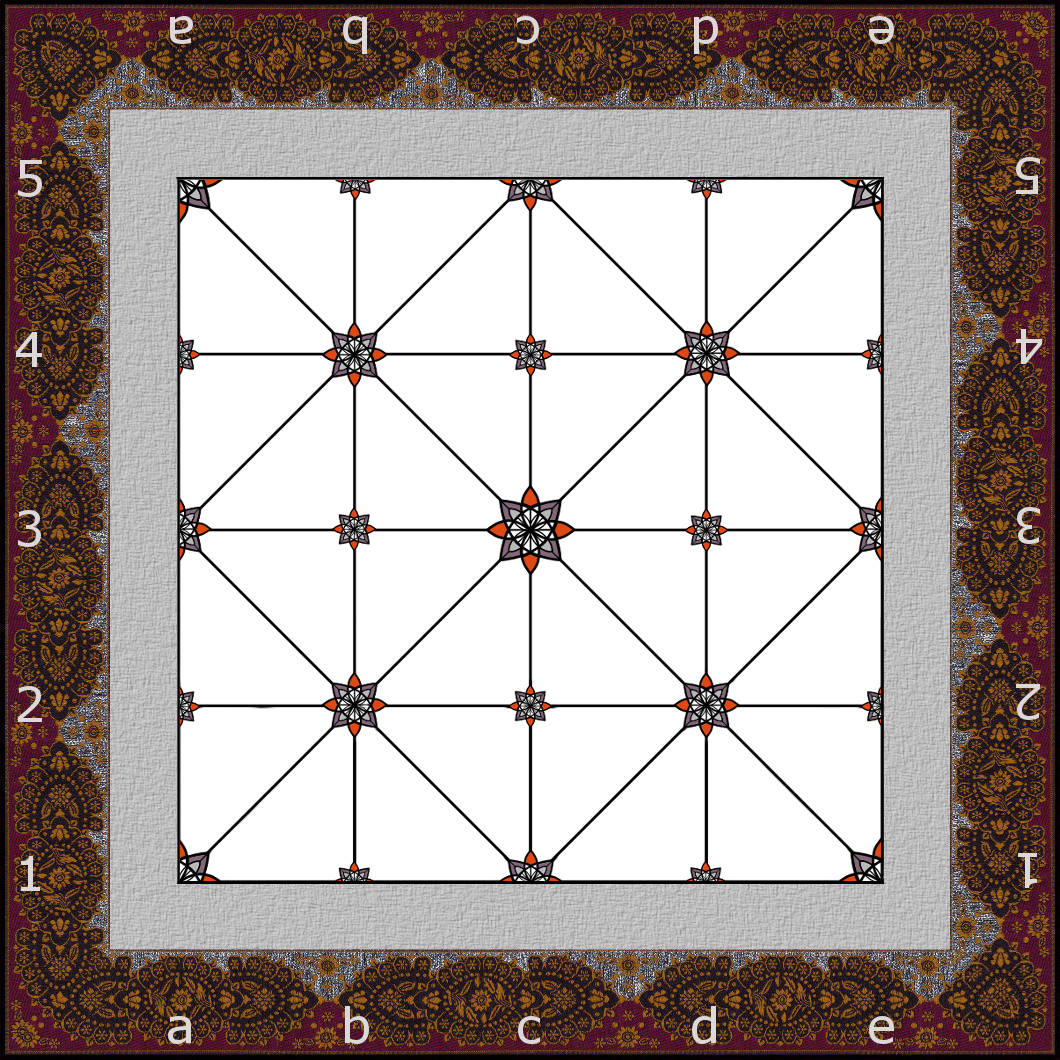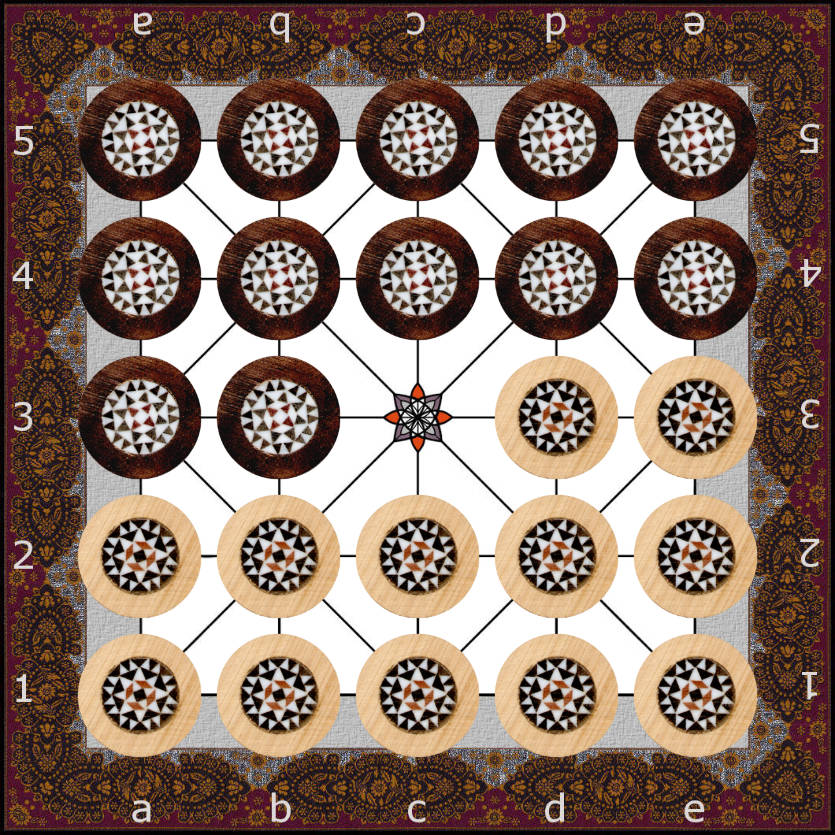 Alquerque
Alquerque
- Start an online Alquerque session on http://omerkel.github.io/Alquerque/html5/src
- Also published in

- Android APK available for install
 https://github.com/OMerkel/Alquerque/releases/tag/release_0.1
https://github.com/OMerkel/Alquerque/releases/tag/release_0.1
- requires minimum Android 4.4.2 (API-19)
- Runs in various browsers on
- desktop systems like BSDs, Linux, Win, MacOS and
- mobile platforms like Android, FirefoxOS, iOS.
Alquerque - 2 player abstract strategic perfect information traditional board game with computer AI option.
Abstract
Alquerque - a board game demonstrator with computer AI using Monte-Carlo Tree Search (MCTS) with UCB (Upper Confidence Bounds) applied to trees (UCT in short). Alquerque is a medieval Spanish board game closely influenced and originated from the Middle East also known there as the game called Quirkat, Qirkat, or El-Quirkat. Etymological studies by Arie van der Stoep seem to strengthen the thesis for evidence of Roman influences. Assumption is that the Arabic qirq or qirqa is borrowed from the Latin word calculus (meaning a pebble or stone piece). If your sources distinguish among various Alquerque game variants then the most likely name for the implemented game found here might be “Alquerque de doze”. The oldest written description might be by Abu al-Faraj al-Isfahani in his works of Book of Songs (“Kitab al-Aghani”). Although the rules were not described in there. An medieval source mentioning rules is the Libro de los juegos affiliated to (or at least commissioned by) Alfonso X el Sabio of León and Castile. Robert Charles Bell came up with modern rule proposals and enhancements later on. This Alquerque implementation has minor rule refinements neither covered by Alfonso X nor Robert Charles Bell. Still the final rule set is close to the suggestions made by R.C. Bell.
Keywords, Categories Monte-Carlo Tree Search (MCTS), Upper Confidence Bounds (UCB), UCB applied to trees (UCT), AI, 2-player board game, deterministic game with perfect information, JavaScript, ECMAScript, W3C WebWorker
Description
This Alquerque is a board game using Monte-Carlo Tree Search (MCTS) with UCB (Upper Confidence Bounds) applied to trees (UCT in short) for the computer player AI. The board game is used for demonstration purposes of the UCT algorithm.
Rules
There are different rules available for Alquerque de doze. The default rules as implemented here are as follows. Mind that some parts of the rules might be altered through selected options.
Game Material

Alquerque is a board game. The rectangular Alquerque board has fixed dimension of 5 times 5 positions horizontally and vertically. Positions on board are connected by a fixed line pattern showing potential paths of movement for players’ checkers. The checkers are placed on the positions (or points) of line intersections in the line pattern. There are two opposing players: one is controlling the light checkers and the other is controlling the dark checkers.
Starting Position

The twelve light checkers are placed on all positions of rows 1 and 2, and positions d3 and e3 initially. Thus the row 1 is referred to as being the base row of the player controlling the light checkers. The twelve dark checkers are placed on all positions of rows 4 and 5, and positions a3 and b3 initially. Thus the row 5 is referred to as being the base row of the player controlling the dark checkers.
Game Mechanics
Alquerque is played alternating players’ turns. The player controlling light checkers moves first. A player either
- must capture opponent’s pieces if possible or
- must perform a normal non-capturing move otherwise.
Passing a turn is not allowed.
Non-capturing Move
Movement of checkers is performed strictly along the lines of the board onto adjacent free positions.
A light checker can not move from it’s position to positions on rows with lower numbers. A dark checker can not move from it’s position to positions on rows with higher numbers. Thus neither a light nor a dark checker can move backwards in direction of the player’s own base row.
A checker that reached the opponent’s base row can not be moved any longer but only capture opponent’s checkers if possible. Anyway the checker is allowed to perform non-capturing moves again, too, if after the capture it is not positioned on the opponent’s base row any longer.
Capturing Move
Captures are compulsory. If capturing is possible on a player’s turn then the player must perform a capturing move. A capture can be performed in any straight direction indicated by the line pattern of the board (even in direction of own base row).
An opponent’s checker on an adjacent position along a line of an own checker is captured by jumping over it in straight line onto an adjacent free position along the line. Jumping to perform captures is done in straight line without any change of direction. Checkers captured leave the board and do not return. By each jump exactly one single opponent’s checker is jumped over and thus captured at a time. Checkers can not jump over or capture checkers of own color. Captures can be done and are mandatory if available any time on own turn after the game has started.
In a player’s turn multiple consecutive captures performed with the same own checker are allowed and compulsory. The player must continue to capture in the possible multiple consecutive capture until no additional capture is possible. It is not necessary to select the longest possible path to capture the maximum opponent’s pieces. On alternative paths the player may decide freely on which one to continue capturing. After each single straight line jump if performing multiple consecutive captures the direction of jumps may be changed although reverse direction change is not allowed. A captured checker is removed from game play instantly while being jumped. Thus it can not be reused to be jumped again in a multiple capture move.
Checkers can not be stacked by moving or jumping on top of the other.
Winning Conditions
A player wins by either capturing all opponent’s checkers or if the opponent can not perform any legal move. With given rules a tie or draw game is only possible if the option Inverting each pieces’ own last move is… allowed is chosen. Per default inverting each pieces’ own last move is strictly forbidden.
References
- Guillaume Maurice Jean-Bernard Chaslot, “Monte-Carlo Tree Search”, PHD Proefschrift, Universiteit Maastricht, NL, 2010.
- Guillaume Chaslot, Sander Bakkes, Istvan Szita and Pieter Spronck, “Monte-Carlo Tree Search: A New Framework for Game AI”, in Proceedings of the Fourth Artificial Intelligence and Interactive Digital Entertainment Conference, Stanford, California, 2008. Published by The AAAI Press, Menlo Park, California.
- Alfonso X el Sabio, “Libro de los Juegos” or “Libros del Axedrez, Dados et Tablas”, 98 double-sided pages, available at the monastery library Real Sitio de San Lorenzo del Escorial, Madrid, Spain, written from 1251 to 1282.
- Transcript/Translation into English by Sonja Musser Golladay
- Robert Charles Bell, “Board and Table Games from Many Civilizations”, Volume 1, Dover Publications, US, 1979.
- Sonja Musser Golladay, “Los libros de acedrex dados e tablas: Historical, Artistic and Metaphysical Dimensions of Alfonso X’s Book of Games”, PhD Dissertation, 591pp., The University of Arizona, US, 2007.
- http://hdl.handle.net/10150/194159
- http://jnsilva.ludicum.org/HJT2k9/AlfonsoX.pdf
- Arie van der Stoep, “The origin of morris and draughts by etymology”, in Board Game Studies Journal, Issue 9, 2015, ISSN 2183-3311, http://bgsj.ludus-opuscula.org, published by Associação Ludus, Lisboa, Portugal, 2015.
3rd Party Libraries
- jQuery: MIT licensed, https://github.com/jquery/jquery
- jQuery Mobile: MIT licensed, https://github.com/jquery/jquery-mobile
- Raphaël: MIT licensed, https://github.com/DmitryBaranovskiy/raphael
Links
- Association for the Advancement of Artificial Intelligence, http://www.aaai.org
- HTML Living Standard, Web Workers, https://html.spec.whatwg.org
- Standard ECMA-262 ECMAScript Language Specification, http://www.ecma-international.org/publications/standards/Ecma-262.htm
- Alphonso X - Book of Games - A Game Researcher’s Resource, http://historicgames.com/alphonso
- Board Game Studies Journal, http://bgsj.ludus-opuscula.org
Contributors / Authors
Oliver Merkel, |
 |
All logos, brands and trademarks mentioned belong to their respective owners.
